Tubeless bicycle tires are in wider use than ever before. Installing them (especially at home instead of in a professional bike shop) can be a hassle - difficult, time consuming, and sometimes impossible. With these tips, you can tame your tubeless tires, making installation faster and easier.
The right tools and the proper technique make all the difference. Here we go:
Tires which have been stored folded and kept in a cold basement will be tough to seat and inflate tubeless. With tubeless, we don't have the advantage of the inner tube forcing the tire beads into the right spot as the tube inflates. You can run into a similar challenge when you're on-site at a Winter cyclocross race - tubeless cyclocross tires will be much easier to mount and seal when they're warmed up first.
For more tubeless success, warm the tires up first, outside in the sun, or even with a hairdryer. If the tire has been folded, open it up into the hula-hoop shape and allow it to take the form of a tire again before you try to mount it up - preferably the day before.
Bike shops and pro mechanics don't struggle with floor pumps - they use air compressors and proper inflator tools designed specifically for bicycles. An air compressor is like the "easy button" for working with tubeless tires.
If you're interested in adding an air compressor to your arsenal, check out this article with complete step-by-step instructions: How to setup a home air compressor for use with tubeless bicycle tires. In addition to the compressor, you'll need an inflator tool that matches the tubeless valves on your bikes (presta or schrader.)
Regardless of whether you're using an air compressor or a floor pump, the core of your valve can actually get in the way, because it limits the total air volume that can pass through.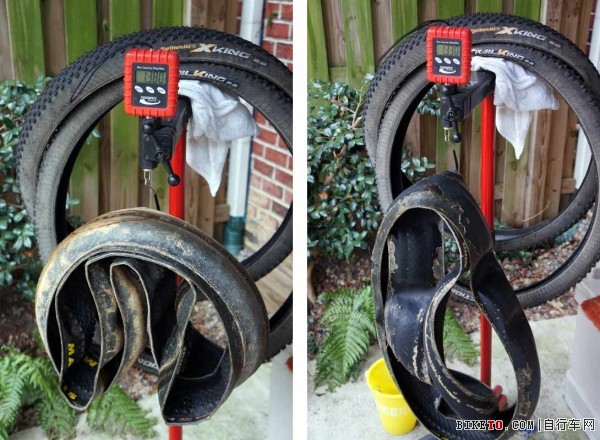 We need a big blast of high-pressure air to seat tubeless tire beads. If needed, you can remove the valve core, then try again to seat the bead. Sometimes with the valve core out of the way, a little bit more air volume can get through - and sometimes that little extra pressure is what you need.
We need a big blast of high-pressure air to seat tubeless tire beads. If needed, you can remove the valve core, then try again to seat the bead. Sometimes with the valve core out of the way, a little bit more air volume can get through - and sometimes that little extra pressure is what you need.
All the air will immediately escape through the valve as soon as you remove the pump or inflator head, of course - you'll need to re-install the valve core (after the beads are seated) to make it airtight once again.
Once you've got the tire beads seated, let's not mess with it again! Using a good quality tire sealant means more time will pass before we have to repeat the process, since the sealant dries out through evaporation over time. The gold standard is Stan's NoTubes sealant. You might also want to add a bit more sealant than you think you need - check the sealant manufacturer instructions for guidelines on how much.
Once your tubeless tire is mounted, avoiding un-mounting it if possible at all costs. That includes when adding sealant. To reduce time in the shop, always top-off the sealant by injecting it through the valve if possible, instead of breaking the tire bead again. Inexpensive sealant injectors make this easy - remove the valve core, inject the sealant, and replace the valve core.
That includes when adding sealant. To reduce time in the shop, always top-off the sealant by injecting it through the valve if possible, instead of breaking the tire bead again. Inexpensive sealant injectors make this easy - remove the valve core, inject the sealant, and replace the valve core.
For a tubeless tire to seat properly and become airtight, we need the tire bead to slide into place - moving from the deep center channel of the rim, to the outer edge, where the tire bead can mate up against the hook of rim. You'll know it happened when you hear the bead pop into place with a satisfying "snap" noise.
Sometimes the rubber of the tire bead sticks on the rim strip, preventing it from popping into place. If this happens, try lubricating the tire bead with a little bit of soap suds - just mix up some dish soap in a little bit of warm water. We really don't need the water, just the suds. Apply some bubbles with a sponge to ease the process of seating the bead.
Sometimes you get a tire/rim combo that just won't work, no matter your tools or technique. In this circumstance, remove the tubeless valve, install an inner tube, and inflate the tire normally.
After riding it around for a couple days, remove the inner tube (taking care to only dismount one side of the tire), re-install the tubeless valve, install your sealant, then mount the remaining side of the tire. With one side of the tire bead already in place, you'll typically find the one remaining side much easier to get working tubeless.
This trick works because the air pressure inside the tube forces the tire bead outward to where it belongs. Once it's in place, it tends to stay there, even after the tube is removed.
Back to blogTable of contents
Floor Pump Air Compressor Tubeless Cannister Inner Tube CO2
Getting a tubeless tire seated onto the rim can be a breeze, it can be a night mare, and just about anywhere in-between. With just a few simple tips it can certainly be on the easier side of the spectrum.
With just a few simple tips it can certainly be on the easier side of the spectrum.
We'll go through a few different methods, tips and tricks, and a how to guide to help you go from the easiest possible methods down to your last resort to make sure your tire gets mounted without much fuss.
The most preferred method of seating a tubeless tire is using your standard floor pump. Mount the second bead, pump up the tire, done. With tire and rim manufacturers starting to get better with size standards, that is more and more possible than it was in years past and will likely be commonplace in the somewhat near future.
The reason this is so favored is because it has none of the downsides every other method can have. The one big issue it does have is that if it doesn’t work…it doesn’t work. There are a few tips and tricks that you can use if just inflating doesn’t work and you want to avoid using other methods.
These can be used for all the methods but are probably the most utilized in seating a tubeless tire with a floor pump.
 This is not an ideal tip, but it has helped some in the past and might just be the missing piece to your set up.
This is not an ideal tip, but it has helped some in the past and might just be the missing piece to your set up. Using an air compressor is the next best method of seating tubeless tires if a floor pump won’t work. Its our preferred method because it is simple and has the fewest downsides.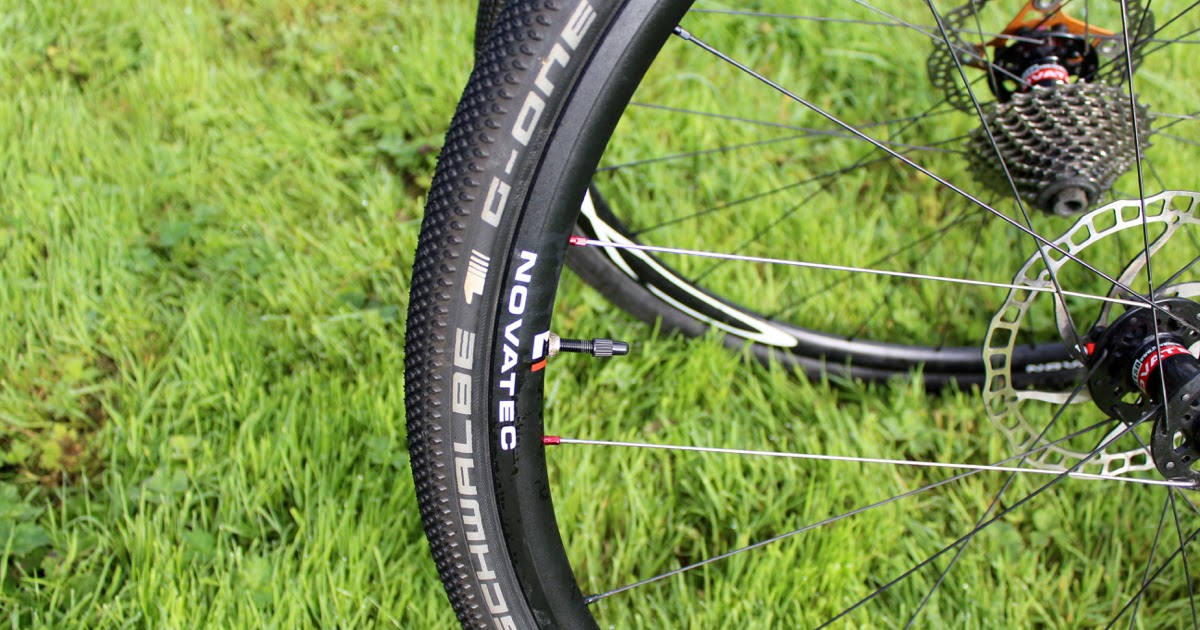 You put the valve at the 12 O’Clock position and inflate. Easy as that!
You put the valve at the 12 O’Clock position and inflate. Easy as that!
You should hear a few loud pops where the bead is snapping into place. You will get all the air into the tire and be ready to ride. While it is the simplest and most successful solution, there are still some risks to look out.
Natural latex sealant is a base on the acidic scale. Most compressors will produce some level of condensation of water which starts as neutral and can bring the sealant down causing premature drying out. The water can even turn acidic if it sits in the metal compressor for a while which will worsen the problem. The best way around this is to pressurize the compressor just before inflating tubeless tires, don’t allow the compressor to be pressurized for an extended period of time. The other major downside to look out for is that you are able to put so much air into the tire that you can pop the tire off the rim. Just be careful not to overinflate the tire.
The other downsides here are that sometimes people don’t want to purchase an air compressor just to seat their tires. The best part is that there are plenty of great options around $100, or you can go to almost any gas station with a Schrader to Presta converter and use the compressor for about a dollar.
The best part is that there are plenty of great options around $100, or you can go to almost any gas station with a Schrader to Presta converter and use the compressor for about a dollar.
There are many options out on the market that allow you to connect a standard floor pump and inflate a cannister to a high pressure. Then you flip a switch, and it rapidly releases the air through a chuck. This acts as a compressor and has a few pros and cons.
The pro side is that when the canister works as intended, it is very simple. It is also a nice option to take on the road. You can put them in the back of your car and make a last minute tire change on the road, fly in the base of your bike bag, etc. A compressor is pretty difficult to travel with or use away from a power source.
The downsides with a dedicated tubeless cannister start with the fact that it is a dedicated piece of $50-$150 kit that isn’t capable of doing much else.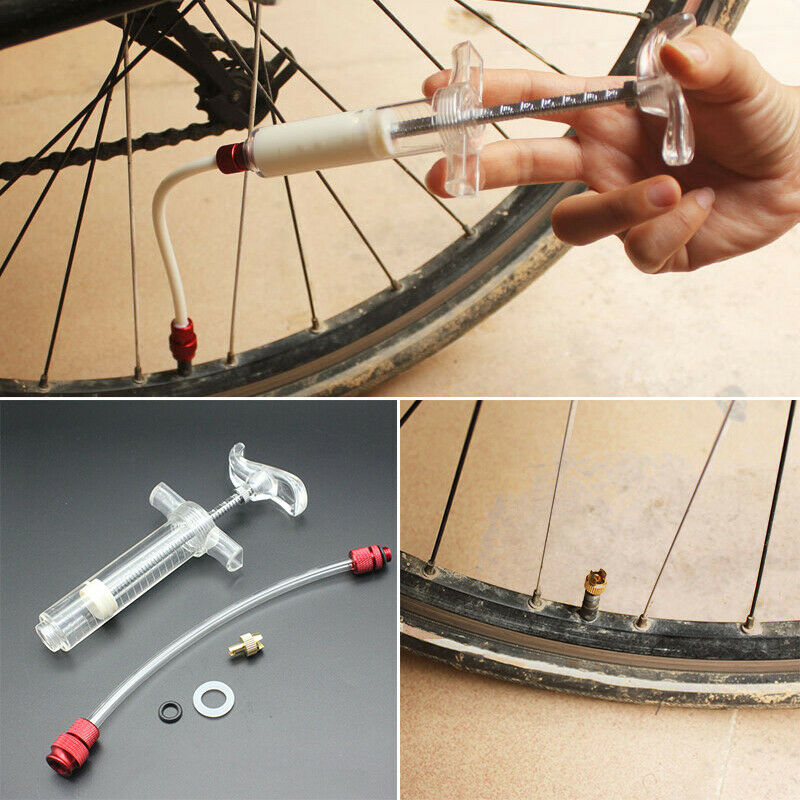 There are also a very wide range of effectiveness of the cannisters. Plenty have poor chucks, leak, etc and they make it very difficult to actually get the tire to seat. When they are able to get a good seal all the way through the system though, they work very well.
There are also a very wide range of effectiveness of the cannisters. Plenty have poor chucks, leak, etc and they make it very difficult to actually get the tire to seat. When they are able to get a good seal all the way through the system though, they work very well.
It sounds a bit odd to suggest using an inner tube to seat a tubeless system, but it can an effective method. You install the tube as you normally would. This seats both beads and you then remove the tube, mount the unseated side (adding sealant if pouring in), and with one side fully seated it is much easier to seat just one.
It can be a method that is messy if sealant is already in the tire and still leaves the issue that it is only seating one side of the tire. This is often a good method if you are going to go to the other tips and tricks to get the tire seated so that you are only trying to get those to seat one side of the tire.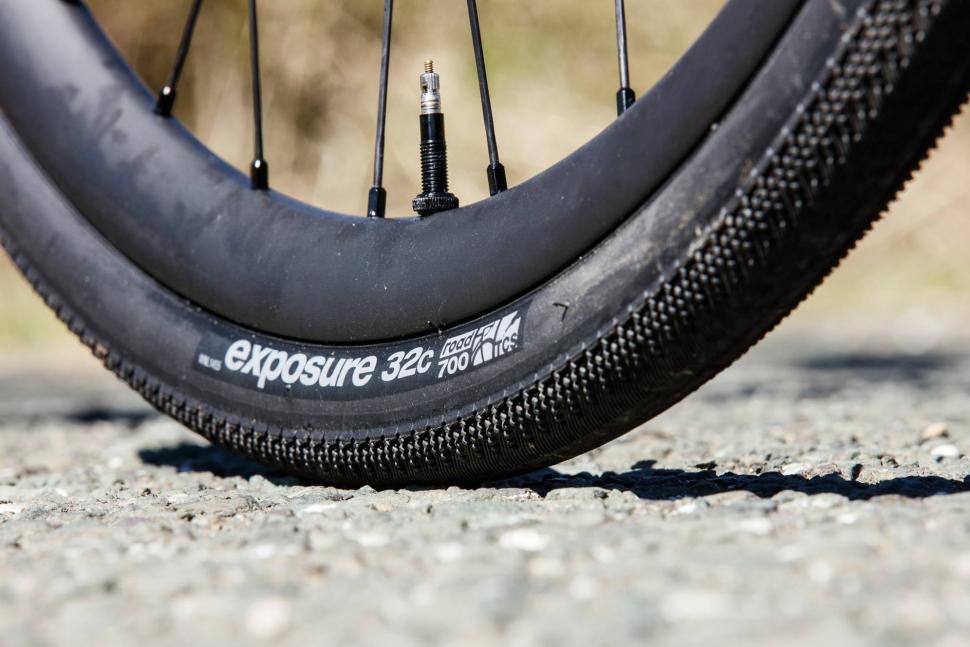
An inner tube can also be used on the outside of the tire to add a bit of compression and make seating the tire a bit easier.
Using a CO2 canister should certainly be the last resort. Using a CO2 canister is an easy solution that is often very successful to get the tire seated. You use it just the same way you would to add air after a puncture.
There are two big downsides to this approach would be firstly that it is a bit wasteful to use a CO2 canister instead of going to the gas station and using a compressor. The second big one is again an impact on natural latex sealant. CO2 can lower the PH of sealant leading to pre-mature drying of the sealant.
If you find yourself in a place where you need to use CO2, you can let the gas out of the tire as soon as possible and refill with air from your pump since the tire is seated. This will get you rolling, and the less time CO2 is in the tire, the lower the likelihood of causing an issue with the sealant.
Do you have other tips that we missed? Leave them in the comments or let us know at [email protected]!
Hydration Pack or Feed Zones, Which is More Aerodynamic?
Tubeless Tire Troubleshooting
Complete Guide to Cleaning Your Chain
Tubeless tires can hardly be called the know-how of the bicycle industry, however, they still raise questions for many. The topic itself, as a rule, is surrounded by a lot of skepticism and distrust, which are more often explained by a lack of understanding of basic things and a lack of experience in riding such wheels. To dispel all these doubts, we answer the main questions related to tubeless technologies.
These are bicycle tires that do not have a tube. At the same time, tubeless technology is not only about tires. We are talking about a whole wheel system, which also includes a special rim and a sealant that gives the wheel anti-puncture properties. The tubeless concept makes the bike more comfortable to use and improves its riding performance, which will be discussed in order.
The tubeless concept makes the bike more comfortable to use and improves its riding performance, which will be discussed in order.
How long ago did this technology appear and can it be trusted?
Those who hear about bicycle tubeless for the first time usually tend to be suspicious of them. You can dislike this technology for subjective reasons, but you definitely shouldn’t distrust it. Tubeless tubes have been massively used for cars and motorcycles for several decades, and during this time they have not given reason to doubt their reliability.
The first tubeless systems for bicycles appeared in 1999, when the French rim brand MAVIC, in collaboration with tire manufacturer Hutchinson, presented their concept of a simple and effective tubeless wheel. In the 2000s, this technology remained the prerogative of mainly professional athletes, who quickly appreciated its main advantages: lighter weight, more air in the wheel, good "traction" and durability.
In recent years, tubeless has finally ceased to be perceived as something exotic.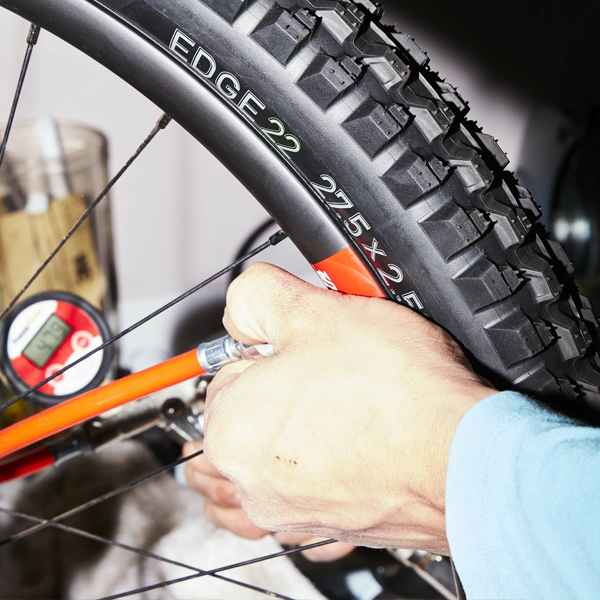 For example, today a significant part of the MTB and almost all touring cars come with such wheels as standard. A wide variety of sealants are also available on the market, and the number of those who are discovering the benefits of tubeless technology is steadily increasing.
For example, today a significant part of the MTB and almost all touring cars come with such wheels as standard. A wide variety of sealants are also available on the market, and the number of those who are discovering the benefits of tubeless technology is steadily increasing.
The tubeless system provides a special rim and tires that are labeled tubeless ready or TR. However, the rims themselves are easy to distinguish visually - they have a low side and characteristic walls with recesses, forming a kind of lock in which the tire cord is wedged when air is injected. Due to this, in the inflated state, the rubber reliably and hermetically “sits” on the rim, without breaking off the wheel even at low pressure. The rim itself is additionally glued with a sealing tape, after which the nipples are installed separately.
The benefits of tubeless wheels are revealed no matter how often and what kind of bike you ride: whether it's weekend trips, extreme downhill or long-distance touring. Nevertheless, for certain categories of cyclists tubeless still open up more opportunities: first of all, we are talking about those who are seriously passionate about off-road.
When actively driving off-road with tubeless tubes, you can ride on lowered wheels and at the same time not be afraid of such an unpleasant type of puncture as a snake bite. Low tire pressure, in turn, gives better handling, dampens vibrations more effectively and generally provides more comfort on difficult tracks. If we are talking about cyclists, then they appreciate tubeless for their anti-puncture qualities.
Road bikes also use tubeless wheels. Moreover, they are the pioneers of this technology. But road tubeless tubes are a different story: they are designed for different operating pressures and have tangible design differences. Therefore, further we will talk mainly about those tires that are put on mountain, touring and city bikes.
These are the two rim formats that define the features of a tubeless wheel assembly. BST is a standard that involves the installation of a special sealing tape that prevents air from leaking through the holes in the spokes. This is the most common version of tubeless systems.
UST is a blind rim in which an additional bridge isolates the spoke holes. Thus, there is no need for laying a sealing tape. In practice, this greatly simplifies life, because when installing a tire (especially without proper experience), the tape tends to crush, which is why you have to reassemble the wheel. It is easy to guess that such rims also have a drawback - their price.
The tubeless system in the form in which we wrote it above is already a full-fledged wheel, it can be installed on a bicycle and hit the road. But there is an important nuance. First of all, tubeless tubes are valued for their anti-puncture qualities: for this, a small amount of a special liquid, a sealant, is poured inside the tire.
Yes, you can. But you should not do this. Firstly, this is illogical: for no reason you are depriving yourself of the main advantage of tubeless - the anti-puncture effect. But more importantly, it is very difficult (or even impossible) to inflate such a tire in a completely flat state with a portable pump: to do this, you need either a strong floor pump or a booster. Naturally, no one will take such bulky things with them on the road. Filled with sealant 95% of punctures "seal" without a critical loss of pressure, and in most cases there is no need for even light pumping. Thus, the probability of being with a flat tire is very low.
So, if you put tubeless, sealant is still needed. Such fluids are easy to find in any bike shop, they are inexpensive and require replacement on average once every three to four months, so there is no need to talk about any inconvenience. Yes, in order to cope with the fill, you need to acquire a certain skill, but this is much easier than constantly changing broken cameras. In addition, sealant can be replaced once a season in a specialized service.
Bicycle sealants are based on fine particles (rubber or polymer fibers) suspended in a liquid carrier. Inside the wheel, the sealant does not polymerize: it is in a liquid state and is distributed along the inside of the tire during movement. When a puncture occurs, the air flow begins to push the solution out. A fine suspension clogs the hole, and the sealant dries quickly. Thus, there is a reliable "sealing" of the puncture.
If we talk about typical punctures - collisions with thorns, wires, small glasses - such damage is self-healing without a noticeable loss of pressure. Usually, a puncture can only be guessed from a small spot on the surface of the tire. Naturally, the sealant works with more complex damage. You can count on it even if you pierce the wheel with a thick nail, 4-5 mm in diameter. If you don't understand how a liquid can seal such holes, you can watch numerous crash tests on YouTube that demonstrate the miraculous properties of sealants.
The consumption per tire is from 50 to 100 ml. If we are talking about standard MTV tires, the golden mean is about 60 ml per wheel. The exact dosage will always be written on the bottle. It is difficult to get confused even for those who do not like to read instructions: most sealants have measuring containers or a dosage scale on the bottle itself.
Here, too, everything is conditional and depends on the characteristics of the specific composition and intensity of punctures. In the absence of serious damage that entails the leakage of a large volume of sealant, you can easily skate a whole season on one fill. Some cyclists prefer to do an incomplete start-up gas station and gradually add 20-30 ml of fluid every two to three months. You can also navigate by how effectively the sealant works: if you see that small punctures are sealed with a strong deflation of the wheel, it may be that the composition is no longer enough and it needs to be added. Be that as it may, sealant is a very economical thing that lasts for a long time.
The sealant inside the tubeless tends to dry out, forming a characteristic film. Whether or not to clean the tire cavity is up to you. This is a purely aesthetic moment, which does not affect the operation of the anti-puncture fluid. The sealant can simply be added as it dries and not bother with unnecessary worries. It is more likely that the tire will completely wear out than it will have time to completely clog with dried filler.
Serious damage - large diameter punctures, small cuts, run over nails with subsequent tire rupture - are repaired using special repair worms. These are rubber or fibrous bands that are inserted into the hole to reduce its area and allow the sealant to seal the puncture.
With long longitudinal cuts it is more difficult. Here you need to either sew up the dissection with nylon threads, or stick a patch on the inside of the tire. You don’t have to worry about the tightness of the repair site - the sealant will do this work, of course, if it does not have time to leak out. But being able to inflate a completely flat tire with only a portable pump will require skill.
In fairness, we note that such complex injuries are rare for most cyclists. But for those who are seriously passionate about off-road, it is better to play it safe with a spare camera. In this case, having caught a cut, you can always drain the sealant, unscrew the nipple from the rim and install a regular camera. And in order not to drive with a “hernia” protruding outward, we recommend placing, for example, a bill folded in half under the cut on the tire.
Tubeless allows you to forget about such an unpleasant form of damage as a "snake bite" forever. It usually happens when at full speed you catch a pothole in the pavement, unsuccessfully jump onto a curb or run into a stone on a downhill. Hitting the edge of a hard object, the tire is crushed, and the rim walls work like incisors, damaging the chamber in two places. In tubeless wheels, this scenario is excluded, because. there is nothing to break through here. Of course, it can be assumed that the rim will cut the tire itself, but this should be a blow of enormous force, which is almost never encountered in practice.
Rejection of the chamber increases the volume of air in the wheel. This changes the contact patch (it becomes flatter) and allows the wheels to better absorb off-road bumps. Add here the ability to ride at low pressure, without being afraid of a snake bite, and it becomes completely clear why tubeless lovers of hard off-road riding so idolize. Soft tires with a large contact patch "fit" all the bumps in the road, giving excellent traction on rocks, forest primers and other off-road.
In addition to traction, tubeless tires improve shock absorption, dampen vibrations better, and generally provide more off-road comfort. At the same time, to get the most out of this rubber, you need to experiment a lot with tire pressure, trying to find the indicators that will best suit your individual riding style.
Finally, the camera is extra grams. By refusing them, you can save an average of 70-100 g of weight on each wheel. For some, this may seem like a formality, but it is worth considering the fact that extra grams on the periphery of the wheel have a stronger effect on driving performance. This difference is especially felt on road bikes: road bikes, gravel, touring.
They also exist. Moreover, it is far from formal. First, it's the price. The difference becomes especially noticeable when you buy tubeless systems separately: rims, tires + small things (tape, removable nipples, sealant). For tubeless you will have to pay an average of one and a half times more than for ordinary wheels, plus or minus the same class. And if we are talking about more advanced UST rims, then this means another + 30-40% to the cost.
With tubeless by default, everything is more difficult in terms of installation (here we are talking about conventional BST systems). You need to learn how to properly glue the tape, accurately insert the nipples, carefully install tight rubber, making sure not to displace the tape and not fill everything with sealant. On the other hand, all this comes with experience, but what you will always have to put up with is the difficulty with pumping a completely flat tire.
A tubeless tube cannot be inflated until its landing board snaps into place on the rim. To do this, you need to sharply introduce air into the tire. The tire should straighten up and fall into the grooves with a characteristic click - then it can be safely pumped further. This all sounds simple if there is a compressor in the garage. Putting a tubeless tube into the grooves by pumping air with an ordinary floor pump is quite difficult, and almost impossible with a portable bicycle pump.
All this makes life much more difficult. But there are solutions. In the field, a compact can of compressed air can help out. At home, installing tubeless tubes greatly simplifies the booster. This is a cylinder into which a high pressure is pumped with a pump, then it is connected to a nipple, the valve is lowered - and the air from the reservoir pumps up the wheel sharply.
As you can see, tubeless cameras also have enough disadvantages, but it is wrong to consider them in isolation from the advantages. For example, the probability of being with a completely flat tire away from home is very low, due to the anti-puncture qualities. Complicated installation is offset by the lack of punctures and roadside repairs. And by overpaying in price, you save on interchangeable cameras, and, of course, win as a roll on off-road.
Cyclists who use tubeless tires know very well what kind of hemorrhoids to put a tubeless tire on a rim, especially somewhere in a field or at a training camp in Turkey, far from civilization.
Ideally, you need a compressor with a receiver that can provide good air pressure, or a good floor pump. But there are also dances with a tambourine with a pump if the sidewall of the tire does not fit snugly against the rim. In this situation, shaving gel saved me. I poured the gel abundantly into the gap between the rim and the tire, and after that it turned out to inflate the tire with a floor pump. But this, in my opinion, is not quite the right solution, because:
Firstly: need gel + floor pump
Secondly: gel costs money, and its consumption is not small what mixing gel and sealant will do. Perhaps this poop in the wheel is the result of mixing sealant and shaving gel?
You will have to remove the tire again, seal the hole, again pile on the gel, pump it up. In general, at home for me it was not a very comfortable activity, although I like to mess with the bike.
The decision was born spontaneously. My friend, Dmitry, called me and said that you can use a two-liter bottle of sparkling water as a receiver, it can easily hold up to 7 Atmospheres and it was necessary to come up with a device so that you could pump it up with a pump, and then, inflate the tire with air from her.
Together, a scheme was born, and then it was implemented. Personally, I doubted a little about its performance, but it worked!
Diman scooped it up quickly, but it turned out a little clumsy. The first pancake, so to speak, is lumpy ... Looking at the design, for some reason an association arose in my head -
Kirogaz ...
Then Diman modified the device and was
Kirogaz version 2
9000
Having experienced that the device was the annual, I decided to improve it a little, and I decided to improve it a little and it was a little improve this is what I got -
KYROGAZ version 3
Air, which is pumped into a two-liter bottle by a pump to a pressure of 4 atmospheres, is enough to put a tire on the rim, both 26 and 29inch wheel!
The trick in the design is that for a training camp, for example, in Turkey or for a race where you may have to change tires, you don’t need to take a large receiver with you (a suitcase or trunk is already full of junk to the eyeballs).